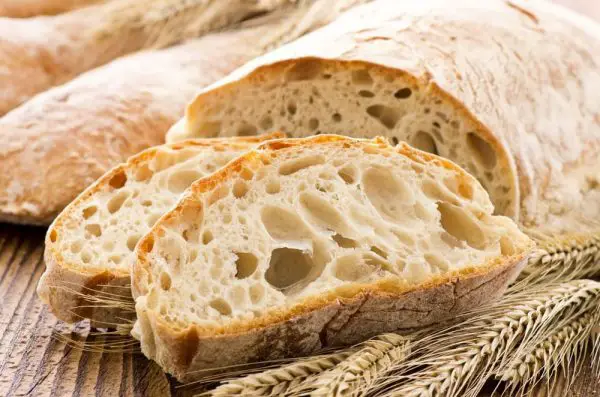
Ciabatta Bread Recipe
Ciabatta bread recipe is a classic Italian bread known for its crisp crust and soft, airy interior. Perfect for sandwiches, dipping in olive oil, or simply enjoying warm with butter, ciabatta has become a favorite in kitchens worldwide. Its name, which means “slipper” in Italian, reflects its flat, rustic shape. While it may seem intimidating to make, this recipe will guide you through each step with ease.
A Brief History of Ciabatta Bread Recipe:
Ciabatta bread has relatively modern origins, dating back to 1982. It was created by an Italian baker, Arnaldo Cavallari, as a response to the growing popularity of French baguettes. Cavallari wanted a bread that was distinctly Italian but could also rival the baguette’s versatility. Using high-hydration dough, which gives ciabatta its unique texture, he introduced this bread to the world. Today, it’s a staple in Italian bakeries and homes.

Ciabatta Bread Recipe
Equipment
- Mixing bowls
- Kitchen scale (optional for precise measurements)
- Wooden spoon or stand mixer with a dough hook
- Parchment paper
- Baking sheet or pizza stone
- Clean kitchen towel
Instructions
- Prepare the DoughIn a large mixing bowl, combine the flour, yeast, and salt. Add the lukewarm water and olive oil. Mix with a wooden spoon or in a stand mixer until the dough comes together. The dough will be very wet and sticky—this is normal!
- Let the Dough RestCover the bowl with a clean kitchen towel or plastic wrap. Allow the dough to rest at room temperature for 8–12 hours. During this time, the dough will rise significantly and develop flavor.
- Shape the LoavesDust your work surface with flour. Gently pour the dough onto the floured surface, being careful not to deflate the air bubbles. Use a bench scraper or your hands to divide the dough into two equal portions. Shape each portion into a rectangular or oval “slipper” shape.
- Second RiseTransfer the shaped dough onto a parchment-lined baking sheet. Cover with a kitchen towel and let rise for another 1–2 hours. The dough should puff up slightly.
- Preheat the OvenPreheat your oven to 450°F (230°C). If you have a pizza stone, place it in the oven while it preheats to create a crispier crust.
- Bake the CiabattaCarefully slide the parchment paper with the dough onto the baking sheet or pizza stone. Bake for 20–25 minutes or until the loaves are golden brown and sound hollow when tapped.
- Cool and ServeLet the ciabatta cool on a wire rack before slicing. Enjoy fresh with butter, olive oil, or as a base for sandwiches.
Video
Similar Recipes You’ll Love:
Focaccia Bread – A soft, olive-oil-rich bread with herbs.
French Baguette – Another crusty favorite with a soft crumb.
No-Knead Bread – A simple, hands-off approach to artisanal bread.
Sourdough Bread – Tangy and perfect for advanced bakers.
Pita Bread – A versatile flatbread for wraps and dips.
Frequently Asked Questions About Ciabatta Bread Recipe:
1. What makes ciabatta bread unique?
Its high-hydration dough creates a light, airy crumb and a crisp crust.
2. Can I use whole wheat flour?
Yes, but the texture will be denser. Consider using a mix of whole wheat and all-purpose flour.
3. Do I need a stand mixer?
No, you can mix the dough by hand, but a stand mixer makes it easier to handle the sticky dough.
4. How do I store ciabatta bread?
Store in an airtight container at room temperature for up to 2 days or freeze for longer storage.
5. Can I make ciabatta without olive oil?
Yes, but olive oil adds flavor and helps with the dough’s elasticity.
6. Why is my bread dense?
It could be due to over-kneading, under-proofing, or using too much flour.
7. Can I make ciabatta gluten-free?
Yes, but it requires a specialized gluten-free bread recipe and flour blend.
8. What is the best way to serve ciabatta?
Use it for sandwiches, as a dipping bread, or toast it with butter and jam.
9. Why is my dough so sticky?
Ciabatta dough has high hydration, which makes it sticky but gives it its signature texture.
10. Can I add toppings or mix-ins?
Absolutely! Try adding olives, sun-dried tomatoes, or herbs to the dough.
Conclusion:
Making ciabatta bread at home is easier than you might think. With its chewy texture and crispy crust, it’s the perfect addition to any meal. Whether you’re a seasoned baker or just starting out, this recipe is a great way to enjoy the magic of homemade bread. Pair it with your favorite toppings or simply savor it fresh from the oven.
YouTube Video Credits:
Bincy Chris

Leave a Reply